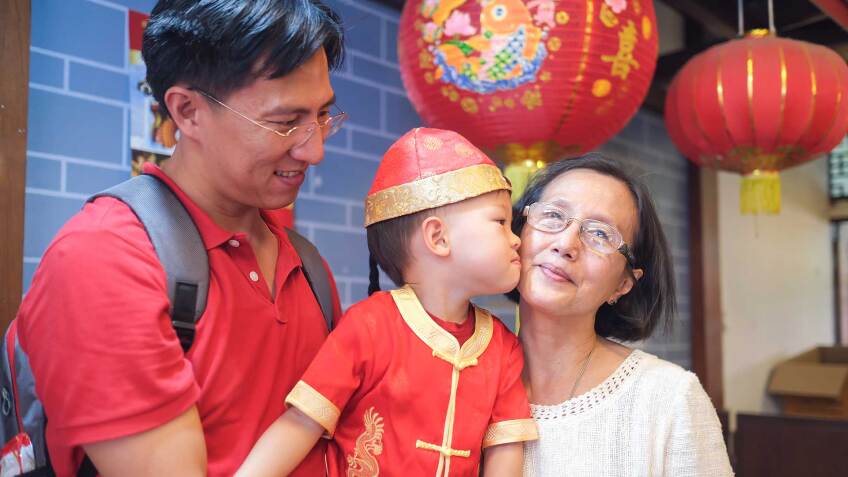8 New Year’s Celebrations from Around the World

Editor's note: If you're reading this in 2022, Chinese New Year kicks off on Feb. 1, representing the Year of the Tiger.
As winter approaches, it’s almost time to close the book of what was the previous year and start a fresh new chapter. A new year symbolizes optimism and hopes for good fortune and abundant opportunities for many cultures around the world. While many New Year’s festivities take place on Dec. 31 and Jan. 1 to mark the end of the Gregorian calendar, many cultures observe the holiday at different times of the year.
Below, we have rounded up a few examples of New Year’s traditions from across the world. Test out a new tradition with your family this New Year’s Eve or keep the celebration (and discussions about different cultures) going with your little ones throughout 2021.
Put Your Best Foot Forward in Scotland
In Scotland, people celebrate Hogmanay, which is the Scottish term for the last day of the year. Before the clock strikes midnight on Dec. 31, friends, family and neighbors visit each other’s homes to be the first person to enter the household for the New Year. The first guest bears gifts, such as coal, shortbread, money, or a black bun — a traditional fruitcake — to bring in warmth and good luck for the forthcoming year.
This ritual, known as “first-footing,” is a common custom in Scotland. At midnight, loved ones also join hands and sing “Auld Lang Syne,” to commemorate the friendships and time that is now passed but not to be forgotten.
Start the Year Off Sweet in Spain
Those in Spain kick off their New Year with exactly 12 grapes. For the first 12 seconds of the New Year, each grape is quickly eaten to symbolize 12 prosperous months filled with good luck ahead.
Each year on Nochevieja, or New Year’s Eve, thousands of people celebrate together by gathering in central plazas or by watching the Real Casa de Correos clock tower in Madrid’s Puerta del Sol with cups of grapes in their hands.
On Jan. 5, children attend parades to celebrate Día de Los Reyes Magos. There, they ask the three Kings Melchior, Gaspar and Balthasar for gifts. Then, at night, before they sleep, the children leave their shoes and plates out in case their wishes come true.
Cheers to a Rich New Year in Armenia
Armenian New Year, once celebrated on Mar. 21, shifted to Jan. 1 during the 18th century. Despite the change in dates, some traditional customs are still practiced, like setting up a lavishly festive table filled with meat dishes, salads, pastries and fruits. Many believe that having a rich and abundant buffet reflects a prosperous year to come.
A mainstay of the table is the gata, which is a sweet baked bread with a coin hidden in the dough. Whoever gets a slice with the coin is said to be the luckiest person in the upcoming year.
Throughout the first week of the year, loved ones visit each other's houses and exchange gifts, usually beginning with parents and close family members, and then friends.
Cue the Fireworks in the U.S.
Many Americans ring in the New Year by having parties with family and friends to count down the final 10 seconds of the year. Some will crowd around the TV or visit New York’s Time Square to watch the New Year’s Eve ball drop, where an illuminated crystal ball slowly descends a minute before midnight. For the first few seconds of the New Year, loved ones will share a kiss, as fireworks are set off in the night sky.
It’s also a custom for adults and children to make New Year’s resolutions as a way to set goals and bring optimism into the coming year. Then, on Jan. 1, families gather to watch parades, such as the Rose Parade in Pasadena.
Mail Some Joy in Japan
The New Year represents a fresh start for many Japanese people. This means leaving behind the troubles of the former year and cleaning the household to ring in the new. With many businesses closed from Jan. 1 to 3, families will spend time together and visit temples, play games, or fly kites (takoage).
Days before the New Year, people mail postcards to loved ones so that they are delivered on Jan. 1. These cards are typically decorated with photos and joyful designs that reflect the Chinese zodiac of the year. People will send them to greet and show gratitude to friends and family. It is also a tradition to give children money and mochi, a Japanese rice cake.
It’s All Things Red in China
Chinese New Year follows the lunar calendar, so the holiday generally lands between January and February, and is usually celebrated for two weeks. Also known as the Spring Festival in China, the New Year represents a new zodiac sign, with 2021 symbolizing the year of the Ox.
Editor's note: If you're reading this in 2022, Chinese New Year kicks off on Feb. 1, representing the Year of the Tiger.
Those that observe the Lunar New Year, decorate their house and don red throughout the weeks of festivities to signify good fortune and happiness. Families will customarily eat dinner together, set off firecrackers and celebrate the Festival of Lanterns. The festival marks the 15th day of the New Year and is a time where households honor family and passed ancestors by partaking in lion dances, lighting lanterns and writing riddles.
Children and elders are also gifted with red envelopes filled with money as a way to send good blessings and to protect them from evil spirits.
Welcome the New Spring in Iran
The Iranian New Year, or Nowruz, not only represents the first day of the New Year in the Persian calendar but it also marks the spring equinox, which is when night and day are about the same length. Typically celebrated around Mar. 20, many Iranian households prepare by cleaning their homes and buying new clothes to get rid of last year’s clutter and to welcome a fresh start.
A “Haft Seen” table is set in the home to represent wishes for the New Year. Every item begins with the letter “S” and traditionally includes sabzeh (growing sprouts in a dish) for renewal, senjed (dried fruit) for love, seeb (apples) for health, seer (garlic) for medicine, serkeh (vinegar) for patience, somaq (berries) for sunrise and samanu (sweet pudding) for wealth.
On the eve of the New Year, children bang on pots and pans and visit their neighbors to ask for sweets.
Light the Way for Good Fortune in India
Diwali is a festival of lights that coincides with the New Year in the Hindu calendar. The holiday usually falls within October and November. For five days, many Hindus, Jains, Sikhs and Buddhists take part in festivities, such as cleaning and decorating their homes with bright colors, lights, flowers and clay lamps. Children will make these lamps, also known as “diya,” to illuminate their house so that the Goddess Lakshmi of good fortune comes and blesses the family.
It is also a tradition for families to have feasts, watch fireworks and exchange gifts to show affection and give best wishes to loved ones.
For many countries around the world, a new year means 365 days filled with endless opportunities and possibilities. Starting the year right means setting goals, having optimism and practicing a few traditions or two.




